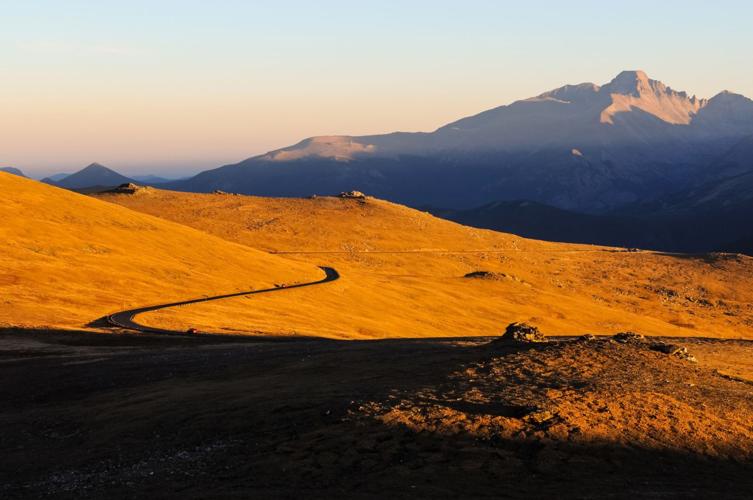Rocky Mountain National Park is located between the towns of Estes Park and Grand Lake, Colorado. Rocky Mountain National Park is home to many peaks, two of which make the fourteener’s list—Long’s Peak and Southeast Longs (The Beaver).
1. Drive Trail Ridge Road.

Sunset at the top of Trail Ridge Road, the highest (12,183 feet) continuous highway in the USA, with Longs Peak (14,259 feet) rising high in the background. Photo Credit: SeanXu (iStock)
There are exactly 48 miles between Estes Park and Grand Lake Colorado along Trail Ridge Road. The road was created in 1931, and an amazing 11 miles of the road are above the tree line, making for awe-inspiring views of the Rocky Mountains. The highest point on the road is 12,185 feet above sea level, and you can expect full sun exposure and blowing winds.
2. Three ecosystems exist in Rocky Mountain National Park.

Mills Lake in Rocky Mountain National Park. Photo credit: Steven Bratman (flickr)
Driving through the vast landscape in Rocky Mountain National Park, you will see three ecosystems marked by three zones of elevation: montane (5600 to 9500 feet above sea level), sub alpine (9,000 to 11,000 feet above sea level) and alpine tundra (higher than 11,000 feet above sea level.) Each ecosystem is marked by different geology, plant, and animal life. What makes Rocky Mountain National Park so amazing is that you can access all of these ecosystems in one afternoon from the comfort of your car as you are driving.
3. Glaciers helped form the landscape.

Longs Peak, Rocky Mountain National Park. Estes Park, Colorado. Photo Credit: Anne Dirkse (OutThere Colorado)
The power of a glacier to carve and sculpt a landscape is evidenced everywhere in the park. Glaciers carrying and pushing small sand granules to large sized boulders have created rock fields. When glaciers melt, rocks are left as single outliers seemingly in the middle of nowhere.
4. Be an Informed Visitor.

Alpine Visitor Center on Trail Ridge Road in Rocky Mountain National Park. Photo Credit: Tim Wilson (flickr)
With more than 4.5 million visitors in 2016, Rocky Mountain National Park’s staff has asked for every visitor to be a good steward of the land. Take the Rocky Pledge before visiting the park and learn some of the basics of good visitor habits and ethics.
5. Leave Fido at Home.

There is an abundance of elk in Rocky Mountain National Park. Photo Credit: blewulis (iStock)
Many places in Rocky Mountain National Park do not allow dogs due to the nature of the wildlife and fragile ecosystems within the park. In general, dogs are allowed anywhere cars can go. They are not allowed on trails.
6. Longs Peak is a magnificent peak.

Longs Peak and Chasm Lake, Rocky Mountain National Park. Photo Credit, courtesy of: John Fielder.
Standing at an elevation of 14,259 feet above sea level, Longs Peak is one of the most prominent mountains seen from the Front Range of Colorado. Make sure you check local conditions before heading out to hike this fourteener; wintery conditions can last until June, making the mountain inaccessible.












(0) comments
Welcome to the discussion.
Log In
Keep it Clean. Please avoid obscene, vulgar, lewd, racist or sexually-oriented language.
PLEASE TURN OFF YOUR CAPS LOCK.
Don't Threaten. Threats of harming another person will not be tolerated.
Be Truthful. Don't knowingly lie about anyone or anything.
Be Nice. No racism, sexism or any sort of -ism that is degrading to another person.
Be Proactive. Use the 'Report' link on each comment to let us know of abusive posts.
Share with Us. We'd love to hear eyewitness accounts, the history behind an article.